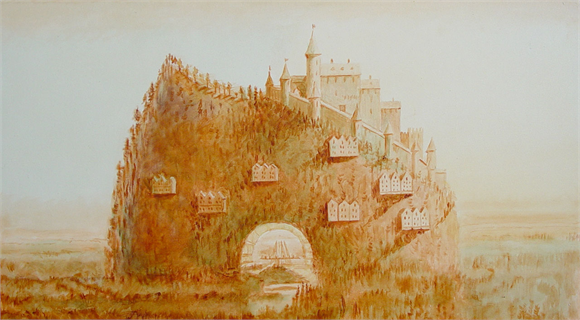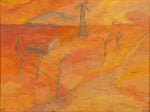Ilya & Emilia Kabakov

A distanza di pochi anni la galleria dedica una mostra antologica esponendo le opere che afferiscono ai cicli più interessanti della produzione di Ilya & Emilia Kabakov. L’opera pittorica, le installazioni e le sculture, ma anche i disegni e i modelli, documentano una pratica che costantemente negli anni si appropria di tutti i mezzi dell’arte.
Comunicato stampa
La Galleria Lia Rumma è lieta di annunciare la mostra personale di Ilya & Emilia Kabakov nella sede milanese. A distanza di pochi anni la galleria dedica una mostra antologica esponendo le opere che afferiscono ai cicli più interessanti della produzione di Ilya & Emilia Kabakov. L’opera pittorica, le installazioni e le sculture, ma anche i disegni e i modelli, documentano una pratica che costantemente negli anni si appropria di tutti i mezzi dell’arte.
Al piano terra, Someone is Crawling under the Carpet (Qualcuno striscia sotto il tappeto) è l’installazione monumentale esposta per la prima volta in Italia e realizzata nel 1998 per la retrospettiva al Museum van Hendendaagse Kunst Antwerpen. L’artista, utilizzando l’espediente poetico del nascondere, simulando con un meccanismo le fattezze ed il movimento circolare di un uomo sotto il grande tappeto, sollecita l’immaginazione dello spettatore creando aspettativa e curiosità.
Il primo piano è dedicato ai dipinti tratti dalla serie In The Studio Of Totti Kvirini. L’opera pittorica di Kabakov, intrisa della riflessione sulla fine dell’universo teorico del Modernismo, con le ideologie e i valori di cui era portatore, è legata all’individuazione di un alter ego come nel caso del progetto Life and Creatvity of Charles Rosenthal del 2000. La pittura, esemplificata con la pratica dell’artista che si ritira dal clamore della vita nello studio a dipingere, con i rimandi alla biografia dell’artista, al suo ruolo nella società, e la memoria del tempo a cui l’alter ego è appartenuto, sono tutti elementi che tessono una fitta rete di relazioni attivata da riferimenti sottaciuti. La tela dipinta si mostra agli occhi dello spettatore munita di un’aura, rimanda a qualcosa d’intangibile che la sola rappresentazione dipinta non esprime.
Le sculture e i disegni esposti nelle teche al centro della sala sono esplicativi di una pratica dell’arte che non si accontenta di utilizzare un medium specifico, ma che sfrutta tutti gli strumenti possibili per la creazione artistica. Un raffinato esempio è la ceramica dal titolo The Pianist and Musa (2000) che ritrae il pianista esausto nel pathos della creazione ad ogni costo.
La fascinazione favolistica e la narrazione fiabesca sono i soggetti della grande installazione esposta al secondo piano. Evening è una delle tre parti della grande installazione Morning, Evening, Night… realizzata in occasione della doppia personale (H.C. Andersen. A Lifeword , 2005) con Joseph Kosuth al Nikolaj, Contemporary Art Center di Copenhagen. La struttura stessa dell’installazione ripercorre i modi narrativi della fiaba costruita come una successione di scatole cinesi. All’interno della sala espositiva è stata costruita una stanza e, all’interno di questa, una finestra simula la fonte di luce naturale che illumina la montagna incantata che conserva nelle sue viscere un carillon. Alle pareti sono esposti grandi dipinti che rappresentano il modello della montagna in mostra all’interno. Lo spettatore non può attraversare la stanza, ma si può affacciare al suo interno da due finestre poste sul fronte e sul retro. I dipinti ritraggono la montagna dal punto di osservazione dello spettatore, ma a guardar bene, oltre a riconoscere nel soggetto l’universo fantastico di Andersen a cui il lavoro è ispirato, è evidente la differenza tra l’immagine osservata dal vero e la sua rappresentazione pittorica. Come le altre installazioni in mostra, Evening cala lo spettatore in un’atmosfera di sogno fantastico tipica delle fiabe nordeuropee.
Ilya Kabakov (Ucraina, 1933) e la moglie Emilia (Ucraina, 1945) hanno già esposto alla Galleria Lia Rumma di Napoli nel 2000 con l’installazione dal titolo The Sick child e con l’installazione dal titolo The Strange Museum a Milano nel 2005. Le loro opere sono presenti nelle collezioni dei più importanti musei del mondo (MOMA di New York, l’Hirshhorn Museum di Washington, lo Stedeljik Museum di Amsterdam, la Kunsthalle di Berna, il Centre Georges Pompidou di Parigi) oltre che in forma di arte pubblica, a Muenster, ad Amsterdam, e a Monaco con The Shining Circus and its Spectators (2004). La Biennale 2007 ha dato ampio spazio al lavoro dei Kabakov che avevano già partecipano a precedenti edizioni, come alla Documenta del 1992. Presso lo Sprengel Museum di Hannover si aprirà il 29 gennaio 2012 una retrospettiva di 60 dipinti intitolata: A Return to Painting. Paintings by Ilya Kabakov, 1961-2011, che dopo aver girato l’Europa, approderà alla De Menil Foundation, Forth Worth Texas, per concludersi in Russia all’ Hermitage e al Garage Centre for Contemporary Culture di Mosca.
............................
The Lia Rumma Gallery is delighted to announce the two-person show of the works of Ilya & Emilia Kabakov at the gallery’s premises in Milan. A few years after their last show, the gallery presents an anthological exhibition of the works linked to the most interesting cycles of the work of Ilya & Emilia Kabakov. Paintings, installations and sculptures as well as drawings and models document an artistic practice that has constantly made use of the whole range of art media over the years.
On the ground floor, Someone is Crawling under the Carpet is a monumental installation which is on display for the first time in Italy and was made in 1998 for the retrospective exhibition at the Museum van Hendendaagse Kunst in Antwerp. Using the poetic device of concealment, and employing a mechanism to simulate the features and circular movement of a man beneath a large carpet, the artist stirs the imagination of the viewer, arousing curiosity and raising expectations.
The foreground is devoted to paintings taken from the series In the Studio of Totti Kvirini. Kabakov’s paintings, steeped in reflections on the end of the theoretical universe of Modernism, with the ideologies and values of which it was the bearer, are linked to the identification of an alter ego as in the case of the project Life and Creativity of Charles Rosenthal, done in 2000. Painting is exemplified by the practice of the artist who retreats from the clamour of life to his studio to paint, his role in society, and the memory of the time to which the alter ego belonged, all elements which weave a tight network of relations created by concealed references. The painting seems to have an
aura that refers to something intangible which the painted representation on its own does not express. The sculptures and drawings in the display cases at the centre of the room reveal an artistic practice which is not content to use a specific medium but exploits all the possible instruments available for artistic creation. A sophisticated example is the ceramic piece entitled The Pianist and Muse (2000) which portrays an exhausted pianist immersed in the pathos of creation at all costs.
The fascination with fairy tales and story-telling are the themes of the large installation on display on the second floor. Evening is one of three parts of the impressive installation Morning, Evening, Night… made for the twoperson show (H.C.Andersen. A Lifeword , 2005) with Joseph Kosuth at the Nikolaj Contemporary Art Center in Copenhagen. The actual structure of the installation runs through the narrative forms of the fairy tale and is constructed like a series of Chinese boxes. A room has been built within the exhibition area; within the room, a window simulates the source of natural light that illuminates the enchanted mountain containing a music box. On the walls there are large paintings which portray the model of the mountain on display from the inside. The viewer cannot cross the room, but can look inside through two windows placed at the front and the back. The paintings depict the mountain from the vantage point of the viewer but on closer inspection, besides recognising the imaginary world of Andersen that inspires the work, a clear difference emerges between the observed image of reality and its painted representation. Like the other installations in the exhibition, Evening places the viewer in a dream-likeatmosphere typical of the fairy tales of Northern Europe.
Ilya Kabakov (Ukraine, 1933) and his wife Emilia (Ukraine, 1945) have previously exhibited at the Lia Rumma Gallery in Naples with the installation entitled The Sick child (2000) and at the Lia Rumma Gallery in Milan with the installation entitled The Strange Museum (2005). Their works are included in the collections of the most important museums in the world (MOMA in New York, the Hirshhorn Museum in Washington, the Stedeljik Museum in Amsterdam, the Kunsthalle Bern, the Centre Georges Pompidou in Paris) as well as in the form of public art at Münster, at Amsterdam, at Munich with The Shining Circus and its Spectators (2004). The Venice Biennale of 2007 devoted a large space to the Kabakovs’ who had already partecipated to the 1992 Documenta . A retrospective of their work will open at the Sprengel Museum in Hannover on 29 January 2012. Entitled A Return to Painting. Paintings by Ilya Kabakov, 1961-2011, the exhibition will tour Europe before being staged at the De Menil Foundation, Fort Worth Texas, and eventually culminating in Russia at the Hermitage and at Moscow.



